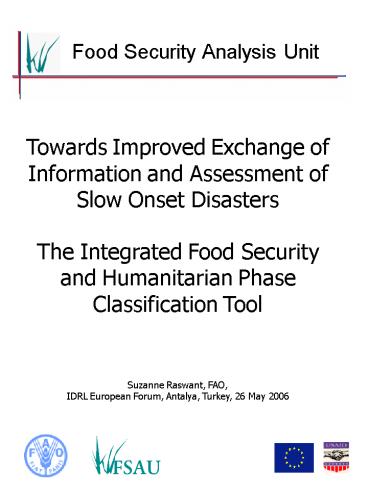Food Security Analysis Unit - PowerPoint PPT Presentation
1 / 15
Title:
Food Security Analysis Unit
Description:
... of analysis ... Preliminary Analysis with Poor Rain Scenario, March 6 2006. For category ... Analysis Templates. Classification Statement (based on ... – PowerPoint PPT presentation
Number of Views:70
Avg rating:3.0/5.0
Title: Food Security Analysis Unit
1
Food Security Analysis Unit
Towards Improved Exchange of Information and
Assessment of Slow Onset Disasters The
Integrated Food Security and Humanitarian Phase
Classification Tool Suzanne Raswant, FAO,
IDRL European Forum, Antalya, Turkey, 26 May 2006
2
Outline
- Why focus on slow onset disasters?
- Situating Situation Analysis and Response
Analysis - Overview of the Integrated Food Security and
Humanitarian Phase Classification - Relevance of Classification to slow onset
disasters
3
Why Focus on Slow Onset Disasters?
- Need early warning and means of tracking
evolution of crisis - Slow onset disasters often recurrence of crises
- Ad hoc needs assessments insufficient too
little, too late - Longer term information systems with surge
capacity most effective - Capitalise on mechanisms for inter-sectoral
sharing of countrywide information set up during
crisis
4
Problems
- No common currency for describing nature and
severity of crises - Inability to compare crises or track their
evolution - Questionable assessment credibility and rigour
- Ambiguous early warnings
- Weak linkages between information and response
- ..
5
Stages in the Analysis-Response Continuum
Situation Analysis
Response Analysis
Response Planning
Response
Monitoring
6
Key Components of Situation Analysis
- Severity (phase classification)
- Geographic coverage
- Magnitude ( people)
- Immediate causes
- Underlying causes
- Identification of general needs
- Current responses
- Criteria for social targeting
- Transitory vs. chronic
- Projected trend / scenarios
- Confidence level of analysis
7
Components of Integrated Food Security and
Humanitarian Phase Classification
- Reference Table
- Mapping conventions
- Analysis templates
- Population Tables
8
Existing Classification Systems
- Oxfam
- Howe and Devereux
- MSF
- FEWSNET
- WFP
- ODI
- Comments
- General definitions
- Limited indicators
- Not inclusive of all stages of FS
- Not explicitly linked to action
9
(No Transcript)
10
(No Transcript)
11
GHA FOOD SECURITY OUTLOOK (Jun.-Dec.,
2006) Preliminary Analysis with Poor Rain
Scenario, March 6 2006
DRAFT
For category explanations see http//www.fsausoma
li.org
Contributors to this Draft FS Outlook Map
Ministry Representatives from some governments
12
Components of Analysis Templates
- Classification Statement (based on convergence of
evidence) - Identify relevant reference characteristics from
table - List direct evidence in support of classification
- List indirect evidence in support of
classification - Identify counter evidence
- For each piece of evidence, provide reliability
and representativeness score
13
IPC is Integrated in terms of
- integrating existing classifications of single
indicators - Integrating lives and livelihoods
- Integrating information and action
- Integrates breadth of food security phases, not
just emergencies - Integrating food security and nutrition
- Integrating short and long term perspectives
- Classification is an analytical statement,
referenced by key outcome reference
characteristics and supported by convergence of
evidence
14
What the IPC is
- A tool for summarizing and communicating
Situation Analysis, based on common standards,
that links complex information to action - A technical forum for enabling technical
consensus
15
What the IPC is not
- A methodit draws from multiple methods
- Response analysisthis is the next step, which is
based on sound situation analysis
16
Relevance to Slow Onset Emergencies
- Enables clear early warning
- Tracks the evolution of a crisis
- Reinforces value of shared information
- Guides effective response as a crisis evolves and
recovers
17
For more information
- www.fsausomali.org
- fsauinfo_at_fsau.or.ke































